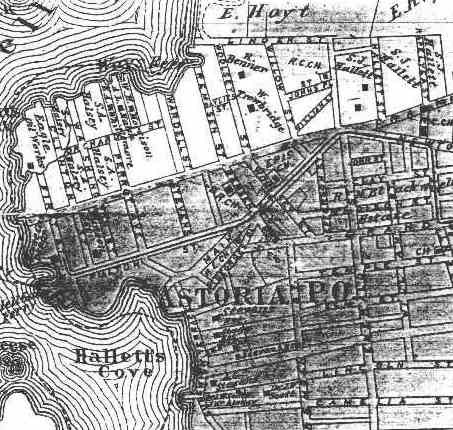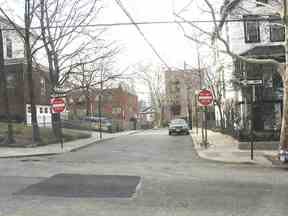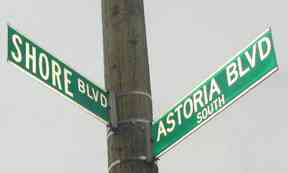Turning to the dusty, dogeared Book of Forgotten Street Names, making a mental note to replace the yellowed scotch tape that holds the cover together, we see that the tome plops open to… Astoria, Queens.
Like Flushing, Astoria’s pedigree dates to the mid-1600s, when William Hallett received a grant for the area surrounding what is now Hallett’s Cove by Peter Stuyvesant. However, the oldest structures in the region date to the mid-1800s, after fur merchant Stephen Ailing Halsey had incorporated the village in 1839.
Astoria was named for a man who apparently never set foot in it. A bitter battle for naming the village was finally named by supporters and friends of John Jacob Astor (1763-1848), not least Stephen Halsey. Astor, entrepreneur and real estate tycoon, had become the wealthiest man in America by 1840 with a net worth of over $40 million. (As it turns out, Astor did live in “Astoria”–his summer home, built on what is now East 87th Street near York Avenue–from which he could see the new Long Island Village named for him.)
Like most other towns and villages in Queens, Astoria (which on this Forgotten page we’ll describe as having the East River on the north and west, Broadway on the south, and Hazen and 51st Streets on the east as its boundaries) carried names for its streets, but it also had its own numbering system, which we’ll also touch on.
Let’s start with Astoria’s first neighborhood…grab a map of present-day Astoria and follow along.
Wealthy businessmen built homes on what are now 12th and 14th Street, some cozy boxes like this one, others large, ornate mansions; sadly, those that remain have been altered nearly beyond recognizability.
Hallett’s Cove
Hallett’s Cove today, the region in Astoria just south of Astoria Park and west of 21st Street, is today a mixture of breathtaking houses, ancient churches and graveyards as well as forbidding, utilitatian housing projects and industrial buildings. The area near Astoria Park, as well as Ditmars to the north, feature views of the Hell Gate (1910) and Triborough (1936) bridges. It’s typical of the resolute nondevelopment of New York City’s waterfront that the closer to the water you get, the more boring the housing gets.
Virtually nothing remains of William Hallett’s original settlement along the cove that today bears his name (flags along the neighborhood’s streetlamps call this area Two Coves–Hallett’s, and Pot Cove, at the foot of Astoria Park South and Shore Boulevard). It was only after Stephen Halsey incorporated a village here in 1839 that strrets began to radiate east and south from the area. Most of them, but not all, were named for local landowners. Even if you didn’t notice the old-style Victorians found in the area, its age can be detected by the narrowness of some of its streets as well as the irregularity of its street pattern; 12th Street changes directions three times, and 26th Road slants askew its neighbors.
Location: Between the East River and Astoria Square, what is now Astoria Boulevard, Newtown Avenue and 21st Street. With its proximity to the East River, it may have been named for Robert Fulton, inventor of the steamboat.
What’s there now? Astoria Boulevard. It was renamed for the section east of Astoria Square.
Location: From Astoria Square at 21st Street and Newtown Avenue east to Newtown (present-day Elmhurst).
What’s there now? Astoria Boulevard. New York City, or rather the small towns and villages that make it up, have a tradition of naming their main routes not for the villages they are in, but rather for the towns to which they lead.
Astoria’s Flushing Avenue was a large part of this tradition: it led all the way to Jackson Avenue, today’s Northern Boulevard, the main route from Long Island City to Flushing.
Even today, Brooklyn’s Flushing Avenue and Queens’ Bayside Avenue continue this practice.
Both Fulton Street and Flushing Avenue were collectively known for awhile as Astoria Avenue.
Location: From 26th Avenue (Orchard Street) south to Astoria Boulevard (Fulton Street)
What’s there now? 1st Street. In 1915, Queens adopted the ‘Philadelphia plan’ of street nomenclature, in which the lower-numbered streets start at the waterfront and increase the further away from it you go.
This was done because at the time, Queens was made up of many small towns, many of which, like Whitestone, Flushing and Astoria, had numbering systems of their own. The new plan would place the entire borough under one system.
Over the next decade, the new system was gradually implemented. Queens lost many colorful street names, and was saddled with a confusing system in which many streets with the same number come together, as in Maspeth.
Location: From 26th Avenue (Orchard Street) south to Astoria Boulevard (Fulton Street)
What’s there now? 2nd Street
Location: From 26th Avenue (Orchard Street) south to Astoria Boulevard (Fulton Street)
Named for Stephen Halsey, who originated the Astoria settlement beginning in 1839
What’s there now? 3rd Street
Location: From 26th Avenue (Orchard Street) south to about Broadway and Vernon Avenue in Ravenswood
What’s there now? 4th Street; south of Main Avenue, Vernon Boulevard; Astoria Housing now occupies part of its route.
The new numbering system skipped 5th, 6th and 7th Streets.
Location: From Franklin Avenue (27th Avenue) south to Fulton Street (Astoria Boulevard)
What’s there now? 8th Street
The DeWayt House, on 27th Avenue (Franklin Street) and 12th Street (Remsen Street), dates to 1845 and the beginnings of Astoria Village
Location: From Astoria Square at Astoria Boulevard and 21st Street west to the East River
What’s there now? 27th Avenue
Location: Dead end street off Stevens Street south of Franklin Street
What’s there now? 28th Avenue. Still a dead end street as it was in 1900.
Italianate mansion on 12th Street. It and its neighbors date to the mid-1860s.
Location: From Shore Boulevard and Hoyt Avenue at Astoria Park south to Fulton Avenue and Taylor (29th) Avenue.
Remsen Street was one of two streets in Astoria (Woolsey was the other) in which elaborate mansions were built in the early days of Astoria Village.
Astoria has never been designated a landmarked naighborhood, so gradually, these historic buildings are being altered beyond recognition or razed entirely.
What’s there now? 12th Street.
Shingle-style house on Woolsey (14th) Street
Woolsey Victorian survivor, with whimsical touches.
Location: From Hoyt Avenue at Astoria Park south to Fulton (Astoria) Avenue at Clark Street (28th Avenue)
What’s there now? 14th Street.
Location: Trowbridge Avenue: From Van Alst Avenue (21st Street) west to Woolsey Street
Orchard Street: from Boulevard (4th Street) west to the East River
What’s there now? 26th Avenue now occupies the route of both streets.
Former Baylies Street
Location: One-block street between Remsen and Woolsey, just north of Trowbridge Avenue (26th Avenue)
What’s there now? 26th Avenue. Baylies Street was named 26th Avenue even though it is not in the same line as the former Trowbridge Avenue, which was also renamed 26th Avenue.
Location: Hoyt Avenue at Astoria Park south to Fulton Avenue (Astoria Avenue)
What’s there now? 18th Street. The renumbering system skipped 14th, 16th and 17th (as well as 13th) Streets
Location: Willow (18th) Street east to Hallett (23rd) Street south of Astoria Park
What’s there now? 25th Road
Location: Willow (18th) Street northeast to Van Alst (21st) Street, south of Trowbridge (26th) Avenue
What’s there now? 26th Road. At 26th Road and 21st Street you can find the Irish Famine Cemetery
Subway station retains 21st Street’s old name.
Location: Winthrop (20th) Avenue southwest through Astoria and Long Island City to Newtown Creek
What’s there now? 21st Street. Along with Vernon Boulevard 21st Street is now the main route between Long Island City and Astoria.
Location: Flushing Avenue (Astoria Boulevard) and Debevoise Avenue (31st Street) west to the East River, along Astoria Park
What’s there now? Renamed Astoria Park South between 21st Street and the East River, but has kept its old name as Hoyt Avenues North and South along the Triborough Bridge approach
Location: From Flushing Avenue (Astoria Avenue) north to Mount Washington Place (25th Road) east of Van Alst Avenue (21st Street)
What’s there now? 22nd Street. This remains one of the narrowest streets in Astoria.
Don’t believe your eyes: Astoria Blvd. South never meets Shore Boulevard. The Astoria PARK South sign is mislabeled by the Department of Transportation.
![]() Location: From Flushing Avenue (Astoria Avenue) north to Mount Washington Place (25th Road) east of Van Alst Avenue (21st Street)
Location: From Flushing Avenue (Astoria Avenue) north to Mount Washington Place (25th Road) east of Van Alst Avenue (21st Street)
What’s there now: 22nd Street. This remains one of the narrowest streets in Astoria.
25th Road and 22nd Street (N. Washington Street and Weil Place) looks much the same as it must have in the 1930s.






























